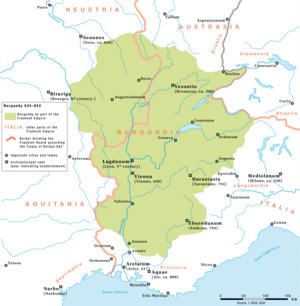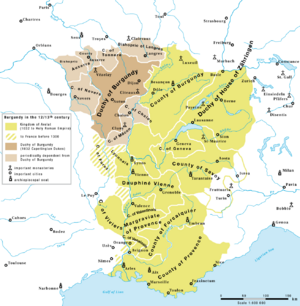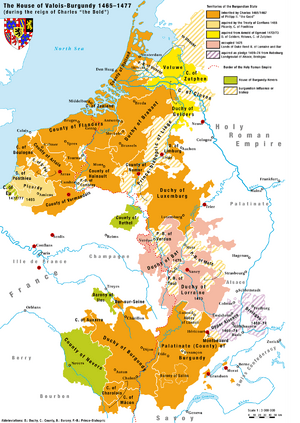Duchy of Burgundy facts for kids
Quick facts for kids
Duchy of Burgundy
|
|||||||||
|---|---|---|---|---|---|---|---|---|---|
| 918–1482 | |||||||||
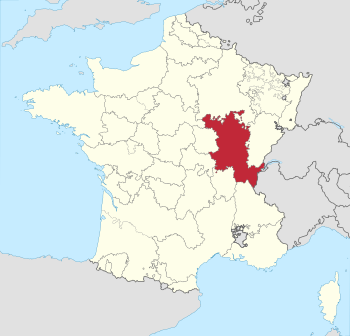
Burgundy before the French Revolution
|
|||||||||

Territories of the House of Valois-Burgundy during the reign of Charles the Bold
|
|||||||||
| Status | Vassal of the Kingdom of France | ||||||||
| Capital | Dijon | ||||||||
| Common languages |
|
||||||||
| Religion | |||||||||
| Demonym(s) | Burgundian | ||||||||
| Government | Feudal monarchy | ||||||||
| Duke of Burgundy | |||||||||
|
• 1032–1076
|
Robert I | ||||||||
|
• 1363–1404
|
Philip the Bold | ||||||||
|
• 1404–1419
|
John the Fearless | ||||||||
| Legislature | Estates of Burgundy | ||||||||
| Historical era | Middle Ages | ||||||||
|
• Established
|
918 | ||||||||
|
• Succession Crisis
|
1002 | ||||||||
| 1337–1453 | |||||||||
|
• Personal union with Burgundian Netherlands and County of Burgundy
|
1384 | ||||||||
|
• Order of the Golden Fleece
|
1430 | ||||||||
| 1474–1477 | |||||||||
|
• War of the Burgundian Succession
|
1477–1482 | ||||||||
|
• Duchy absorbed into French royal domain
|
1482 | ||||||||
| Currency | goldgulden, stuiver, gros | ||||||||
|
|||||||||
The Duchy of Burgundy was a powerful state in Europe during the Middle Ages. It started in the 9th century in what is now France. It was one of the areas that came from the old Kingdom of the Burgundians.
After being conquered in 532, the Burgundian kingdom became part of the Frankish Empire. In 1004, the French parts of the kingdom became a duchy. King Robert II of France gave it to his son, Henry I of France. Henry then gave it to his younger brother, Robert I, Duke of Burgundy, in 1032. Other parts of the old kingdom became the County of Burgundy (Franche-Comté).
Robert I started a new family line of dukes called the House of Burgundy. This family was a branch of the French royal House of Capet. They ruled over an area similar to the modern region of Burgundy.
In 1361, the last duke from this family died. The duchy then went back to King John II of France. In 1363, King John II gave the duchy to his younger son, Philip the Bold. Philip married Margaret III of Flanders. This marriage helped create a larger state called the Burgundian State. This state grew to include lands in the Low Countries, known as the Burgundian Netherlands.
The House of Valois-Burgundy (Philip's family) gained many French and imperial lands. These lands stretched from the Alps to the North Sea. The Burgundian State became one of the largest ducal territories in Europe.
However, after about 100 years, the last duke, Charles the Bold, died in battle in 1477. This led to the Duchy of Burgundy being taken by the French king, Louis XI. Most of the other Burgundian lands went to Charles's daughter, Mary of Burgundy. Her family, the House of Habsburg, inherited these lands.
Contents
What Was the Duchy of Burgundy?
The Duchy of Burgundy came from an older state called the Kingdom of the Burgundians. This kingdom was formed by the Burgundians, a Germanic tribe. They arrived in Gaul (modern France) in the 5th century. They settled near cities like Dijon and Chalon-sur-Saône. The region got its name from them.
In 534, the Frankish King Childebert I took over the Kingdom of the Burgundians. But the area was often re-divided among Frankish kings' sons. So, Burgundy kept some of its own identity.
Burgundy Under Frankish Rule
As part of the Kingdom of the Franks, Burgundy had some freedom. The Burgundians even kept their own law code. But in the 8th century, southern Burgundy was attacked by invaders. Charles Martel drove them out. He then divided Burgundy into four parts. He made his brother, Childebrand I, governor of one part.
Under the Carolingian dynasty, Burgundy became more of a geographical name. It referred to the area of the old Burgundian counties.
How the Duchy Began
Both the Duchy of Burgundy and the County of Burgundy grew out of these counties. This happened as the Frankish Empire became weaker. The Partition of Verdun in 843 divided the Frankish lands.
During this time, a man named Guerin of Provence helped Charles the Bald. Charles was a Frankish king's son. Guerin was rewarded with control over several counties. He was a key military leader on the border. Because of his importance, he was sometimes called dux, which means "leader" or "duke".
Early Dukes of Burgundy
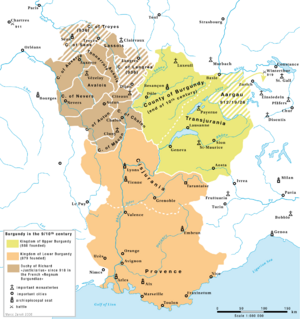
Upper Burgundy Lower Burgundy Duchy of Richard the Justiciar
The Duchy of Burgundy really started to form under Richard the Justiciar (who died in 921). The king officially recognized Richard as a duke. Richard also controlled many counties himself. As Duke of Burgundy, he gained more and more power. The area he ruled was called a ducatus.
Richard brought law and order to these lands. He protected them from the Normans. He also offered safety to monks who were being persecuted.
Burgundy's Rise and Fall
Richard's son, Rudolph of France, became King of France in 923. This made Burgundy very important for a short time. Rudolph used the resources from Burgundy to fight his enemies.
After Rudolph, Hugh the Black (died 952) became duke. His neighbors were the Robertian family, who were Dukes of Francia. This family tried to take control of Burgundy. But they failed.
Later, two brothers of Hugh Capet, the first Capetian King of France, became Dukes of Burgundy. First Otto and then Henry the Venerable kept Burgundy independent. But Henry died without children. This was a big moment for the duchy's future.
The Fight for Burgundy in 1002
When Henry the Venerable died in 1002, there were two people who could claim the duchy. One was his nephew, Robert the Pious, who was King of France. The other was his stepson, Otto-William. Otto-William was count of Mâcon and the County of Burgundy.
King Robert said he should get the duchy because he was the feudal overlord (the king) and the closest relative. Otto-William disagreed and started a war.
If the two Burgundys (the Duchy and the County) had joined under Otto-William, history might have been different. A united Burgundy might have become part of the Holy Roman Empire. This would have changed the power balance between France and Germany.
But King Robert fought for 13 years. He finally took control of all the Burgundian counties west of the Saône River, including Dijon. This meant that Burgundy became firmly French.
A New Line of Dukes
For a while, the duchy was part of the French king's own lands. But it was hard for the king to manage such a distant area. So, King Robert the Pious gave the duchy to his younger son, Robert I, Duke of Burgundy.
In 1032, King Henry I of France (Robert the Pious's son) needed his brother Robert's loyalty. So, he gave Robert even more rights. Robert became the Duke of Burgundy. He could pass the duchy to his children. Future dukes would only owe loyalty to the French crown. This started the era of the Capetian dukes.
The Capetian Dukes of Burgundy
When Robert I became duke, his power was mostly on paper. The duchy had become very chaotic. The dukes had given away much of their land to gain the loyalty of their vassals (nobles who served them). This meant they didn't have much power without their vassals' support.
The Capetian dukes worked hard to get their lands back and make their power stronger. They used laws to take back lands when nobles died without heirs. They also bought land and loyalty from other nobles. They earned money by charging fees for feudal rights. They also managed loans and collected feudal dues.
Growth and Stability
Under the Capetian dukes, Burgundy became more stable. A small court, like the royal court in Paris, grew around the dukes. The duchy was divided into five areas for better government.
Burgundy also became involved in the Reconquista in Spain. This was a series of wars against Muslim rulers. Burgundian dukes made marriage alliances with Spanish royalty. For example, Robert's daughter Constance married King Alfonso VI of León and Castile. His grandson Henry married Theresa of León. They founded the Portuguese House of Burgundy.
Later, the dukes focused on the Holy Land during the First Crusade. Odo I, Duke of Burgundy died during the Crusade of 1101.
Notable Capetian Dukes
Under Robert II (ruled 1271–1306), Burgundy became very important in politics and economy. Robert stopped the practice of giving small lands and titles to younger children. This had weakened the duchy's wealth. He made sure that all lands and income went to his eldest son and heir, Hugh. Younger children would only get payments from Hugh. This made them loyal to the duke.
Hugh V died in 1315. His brother Odo IV took over. Odo was connected to the French royal family. He was the grandson of King Louis IX of France. He was also the brother-in-law of two French kings. He married Joan III, Countess of Burgundy, who was the Countess of Burgundy and Artois. This marriage brought the two Burgundys together again.
The End of a Line
Odo IV and Joan had only one child who survived, Philip. Philip married another Joan, who was the heiress of Auvergne and Boulogne. But they also had only one child who survived, Philip I, Duke of Burgundy. He was also known as Philip of Rouvres.
The elder Philip died in an accident in 1346. Countess Joan III died a year later. When Odo IV died in 1349, the duchy's future depended on young Philip of Rouvres. He was only two and a half years old. He was the last direct descendant of Duke Robert I.
Philip of Rouvres became Duke of Burgundy in 1349. He also inherited the counties of Burgundy and Artois from his grandmother. His mother and her second husband, King John the Good of France, governed the duchy for him.
Philip was set to inherit even more lands. He was supposed to marry Margaret of Dampierre. She would bring Flanders and Brabant to him. By 1361, at age 17, Philip seemed ready to lead Burgundy to even greater power.
But it was not to be. Philip got the Bubonic plague. He died on November 21, 1361. With his death, his family line ended.
The Succession Challenge of 1361
Even before Philip's death, France and Burgundy were thinking about who would inherit his lands. Philip's will said that his lands should go to those who "by law or local custom ought or may inherit." Since his lands came to him through different family lines, they would be inherited separately.
The counties of Auvergne and Boulogne went to Jean de Boulogne. The counties of Burgundy and Artois went to Margaret of France.
But the Duchy of Burgundy was harder to decide. In Burgundy, two rules for inheritance were used:
- Primogeniture: The oldest child inherits. If they die, their oldest child inherits.
- Proximity of blood: The closest living relative inherits.
The two main claimants were Charles II of Navarre and John II of France. Charles II was the great-grandson of Duke Robert II through his older daughter. This gave him a stronger claim by primogeniture. John II was the grandson of Robert II through his younger daughter. This gave him a stronger claim by proximity of blood.
Who Would Rule Burgundy?
If it were just a legal issue, the King of Navarre (Charles II) might have had a good chance. But there was more to it. The Hundred Years' War was happening. Charles II was an ally of England and an enemy of France. The people of Burgundy did not like him. They had been loyal to King John II of France.
Also, John II had the support of John of Boulogne and Margaret of France. These were other heirs to parts of Philip's lands. Their support helped John II's claim. The nobles of Burgundy decided to support John II. He was ready to use soldiers if needed, but the nobles willingly accepted him as their new duke.
King John II of France and Burgundy
When King John II inherited the duchy, some people thought it would become part of the French crown. But this was not true. The duchy had been given to the heirs of Robert I. John II claimed it because he was the grandson of Robert II, not just because he was king.
John II tried to merge the duchy with the French crown. He said that Burgundy would be forever united with France. If this had happened, Burgundy would have stopped being an independent duchy.
But John II did not understand the people of Burgundy. They had accepted him as duke. But they also said that Burgundy would remain a duchy. They did not want it to become just another French province. They said there would be no big changes. They firmly stated that Burgundy would never be fully taken over by France. The king was also the duke, but that was the only link.
John II's plan to absorb Burgundy failed. The Burgundians refused to accept it. The king could not force them. So, he quietly gave up on his plan.
Philip the Bold Becomes Duke
Instead, King John II turned to his youngest son, Philip the Bold. Philip was his favorite and a brave fighter. He had fought bravely alongside his father in the Battle of Poitiers at age 14.
The king decided to honor his son and make the Burgundians happy. He made Philip governor of Burgundy in 1363. The Burgundians, who had not liked the previous governor, supported Philip. Finally, Philip the Bold became Duke of Burgundy. The king secretly made him duke on September 6, 1363. After King John died, the new king, Charles V, publicly confirmed Philip's title on June 2, 1364.
The Valois Dukes of Burgundy
Under the Valois dukes, Burgundy grew very strong. Philip the Bold married Margaret of Dampierre. She was the widow of Philip of Rouvres. This marriage brought the Duchy of Burgundy together with the County of Burgundy again. It also added the rich counties of Flanders, Nevers, and Rethel to the dukes' control.
By 1405, after Philip and Margaret died, their son John the Fearless inherited most of their lands. Burgundy became less like a French territory and more like an independent state. It was a major power in European politics. The Burgundian State included the original Duchy of Burgundy in eastern France. It also included the northern lands that came from Philip and Margaret's marriage.
Conflict with France
Philip the Bold had been careful in politics. But his son, John the Fearless (ruled 1404–1419), was not. Under him, Burgundy and Orléans (another French noble family) fought for power. Burgundy's power grew, but the Burgundian State became seen as an enemy of the French crown.
From John's death, the dukes were treated with suspicion or hostility by French kings Charles VII and Louis XI.
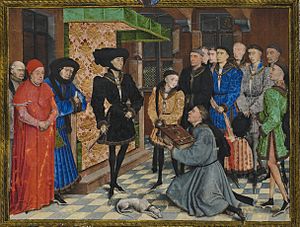
The last two dukes to rule the duchy were Philip the Good (ruled 1419–1467) and Charles the Bold (ruled 1467–1477). They tried to make their state fully independent from France. But they failed.
When Charles the Bold died in battle without sons, King Louis XI of France declared the duchy belonged to the French crown. Charles's daughter, Mary, inherited the rest of his lands. Her family continued to call themselves dukes of Burgundy. They refused to accept the loss of the duchy.
The End of the Duchy
The War of the Burgundian Succession took place from 1477 to 1482. Eventually, King Louis XI of France and Archduke Maximilian of Austria (Mary's husband) signed a peace treaty in 1482. Maximilian recognized that the Duchy and County of Burgundy were now part of France. France kept most of its Burgundian lands. But the rich County of Flanders went to Maximilian and Mary's children.
In 1493, a new treaty was signed. Maximilian got back the County of Burgundy, Artois, and Charolais for his family. But the Duchy of Burgundy and Picardy were permanently lost to France.
What Happened Next?
In 1526, Mary's grandson, Charles V, Holy Roman Emperor, was briefly given the title and land back by the French King Francis I. But Francis I quickly took it back. Charles V never managed to control the duchy.
The territory of Burgundy remained part of France from then on. The title "Duke of Burgundy" was sometimes given to French princes. For example, the grandson of Louis XIV was Louis, Duke of Burgundy.
Today, the King of Spain, Felipe, still claims the title "Duke of Burgundy." His predecessor's coat of arms even included the cross of Burgundy. This cross was the flag of the Spanish Empire at its most powerful.
See also
 In Spanish: Ducado de Borgoña para niños
In Spanish: Ducado de Borgoña para niños





